Critical Review: Ending Homelessness for Women with Mental Illness
VerifiedAdded on 2020/04/15
|6
|1381
|370
Report
AI Summary
This report provides a critical review of an article focusing on ending homelessness among women with severe mental illness. The article, written by Dr. Dennis P. Culhane, examines the initiatives to address homelessness in Philadelphia, specifically highlighting the challenges and successes of programs like Women of Hope. The review discusses the purpose of the article, which is to present the necessity of housing programs for mentally ill women and sheds light on their recovery from mental illness. The report analyzes the problem statement, summarizing the factors hindering effective solutions, such as limited resources and lack of coordination. The results from the Women of Hope program show that a significant percentage of women previously experiencing homelessness were successfully housed and provided with mental health treatments. The review also analyzes the limitations of the programs and suggests further research into effective housing programs and support services. The report concludes that comprehensive approaches are crucial for eliminating homelessness and emphasizes the need for systematic and structural changes in service delivery to improve outcomes. References to relevant literature are also provided.
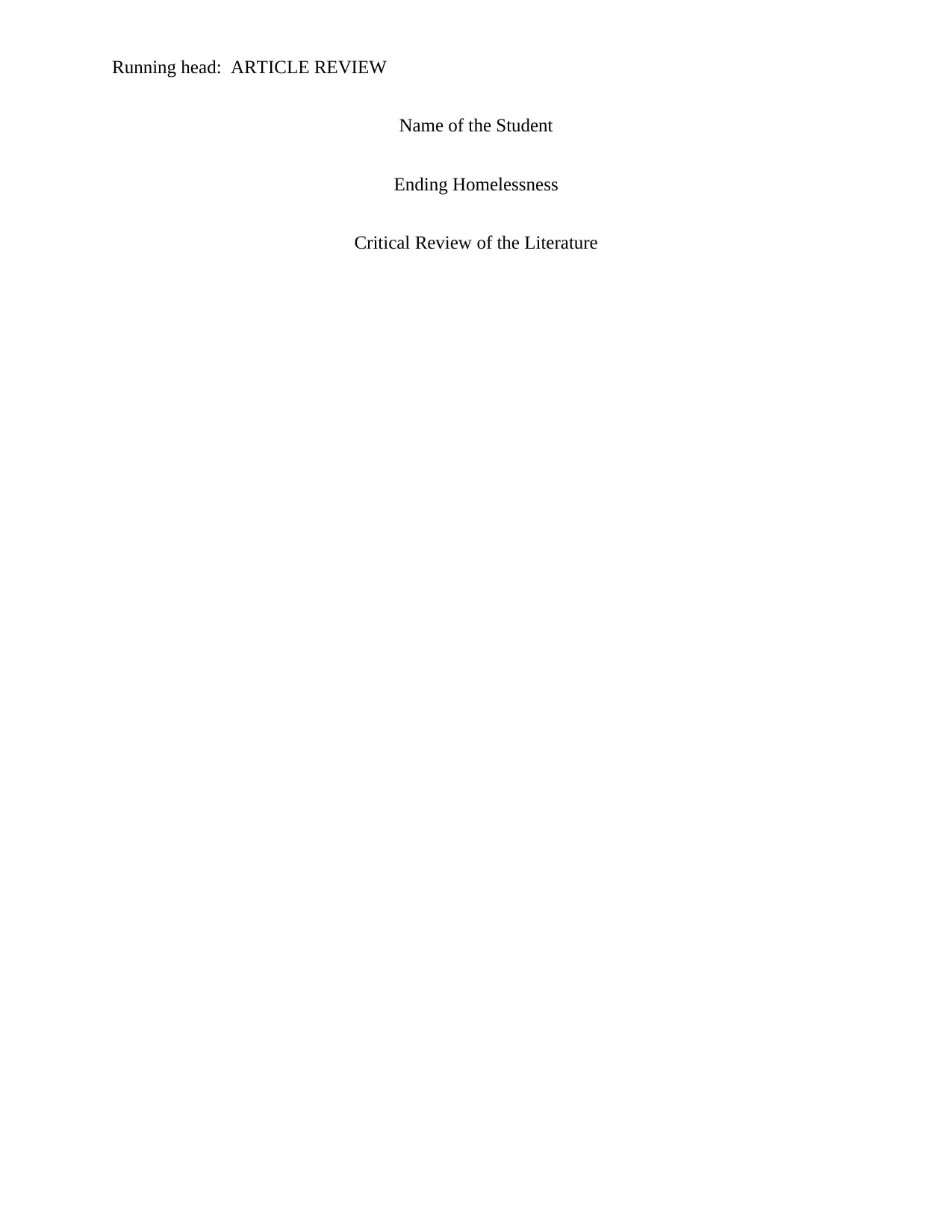
Running head: ARTICLE REVIEW
Name of the Student
Ending Homelessness
Critical Review of the Literature
Name of the Student
Ending Homelessness
Critical Review of the Literature
Paraphrase This Document
Need a fresh take? Get an instant paraphrase of this document with our AI Paraphraser
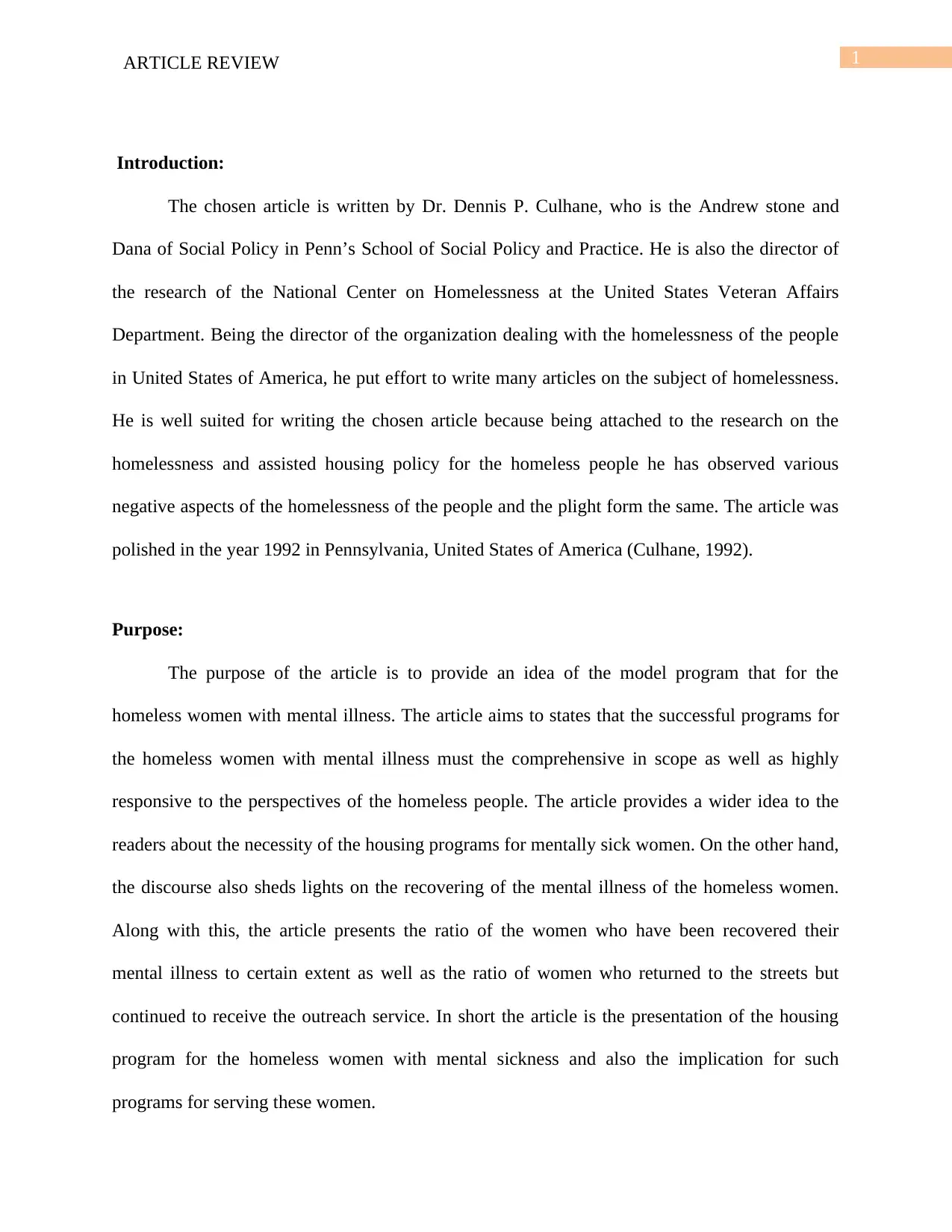
1ARTICLE REVIEW
Introduction:
The chosen article is written by Dr. Dennis P. Culhane, who is the Andrew stone and
Dana of Social Policy in Penn’s School of Social Policy and Practice. He is also the director of
the research of the National Center on Homelessness at the United States Veteran Affairs
Department. Being the director of the organization dealing with the homelessness of the people
in United States of America, he put effort to write many articles on the subject of homelessness.
He is well suited for writing the chosen article because being attached to the research on the
homelessness and assisted housing policy for the homeless people he has observed various
negative aspects of the homelessness of the people and the plight form the same. The article was
polished in the year 1992 in Pennsylvania, United States of America (Culhane, 1992).
Purpose:
The purpose of the article is to provide an idea of the model program that for the
homeless women with mental illness. The article aims to states that the successful programs for
the homeless women with mental illness must the comprehensive in scope as well as highly
responsive to the perspectives of the homeless people. The article provides a wider idea to the
readers about the necessity of the housing programs for mentally sick women. On the other hand,
the discourse also sheds lights on the recovering of the mental illness of the homeless women.
Along with this, the article presents the ratio of the women who have been recovered their
mental illness to certain extent as well as the ratio of women who returned to the streets but
continued to receive the outreach service. In short the article is the presentation of the housing
program for the homeless women with mental sickness and also the implication for such
programs for serving these women.
Introduction:
The chosen article is written by Dr. Dennis P. Culhane, who is the Andrew stone and
Dana of Social Policy in Penn’s School of Social Policy and Practice. He is also the director of
the research of the National Center on Homelessness at the United States Veteran Affairs
Department. Being the director of the organization dealing with the homelessness of the people
in United States of America, he put effort to write many articles on the subject of homelessness.
He is well suited for writing the chosen article because being attached to the research on the
homelessness and assisted housing policy for the homeless people he has observed various
negative aspects of the homelessness of the people and the plight form the same. The article was
polished in the year 1992 in Pennsylvania, United States of America (Culhane, 1992).
Purpose:
The purpose of the article is to provide an idea of the model program that for the
homeless women with mental illness. The article aims to states that the successful programs for
the homeless women with mental illness must the comprehensive in scope as well as highly
responsive to the perspectives of the homeless people. The article provides a wider idea to the
readers about the necessity of the housing programs for mentally sick women. On the other hand,
the discourse also sheds lights on the recovering of the mental illness of the homeless women.
Along with this, the article presents the ratio of the women who have been recovered their
mental illness to certain extent as well as the ratio of women who returned to the streets but
continued to receive the outreach service. In short the article is the presentation of the housing
program for the homeless women with mental sickness and also the implication for such
programs for serving these women.
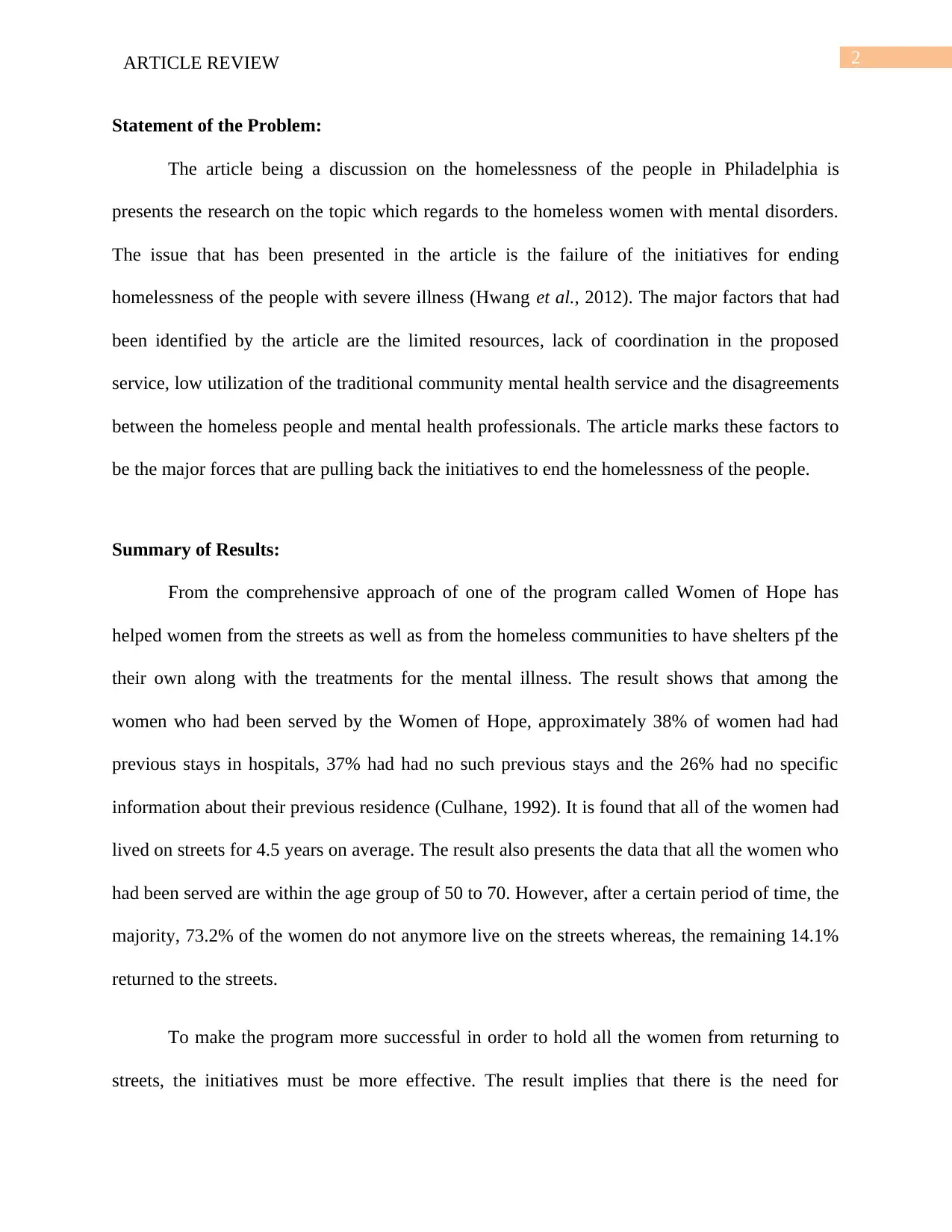
2ARTICLE REVIEW
Statement of the Problem:
The article being a discussion on the homelessness of the people in Philadelphia is
presents the research on the topic which regards to the homeless women with mental disorders.
The issue that has been presented in the article is the failure of the initiatives for ending
homelessness of the people with severe illness (Hwang et al., 2012). The major factors that had
been identified by the article are the limited resources, lack of coordination in the proposed
service, low utilization of the traditional community mental health service and the disagreements
between the homeless people and mental health professionals. The article marks these factors to
be the major forces that are pulling back the initiatives to end the homelessness of the people.
Summary of Results:
From the comprehensive approach of one of the program called Women of Hope has
helped women from the streets as well as from the homeless communities to have shelters pf the
their own along with the treatments for the mental illness. The result shows that among the
women who had been served by the Women of Hope, approximately 38% of women had had
previous stays in hospitals, 37% had had no such previous stays and the 26% had no specific
information about their previous residence (Culhane, 1992). It is found that all of the women had
lived on streets for 4.5 years on average. The result also presents the data that all the women who
had been served are within the age group of 50 to 70. However, after a certain period of time, the
majority, 73.2% of the women do not anymore live on the streets whereas, the remaining 14.1%
returned to the streets.
To make the program more successful in order to hold all the women from returning to
streets, the initiatives must be more effective. The result implies that there is the need for
Statement of the Problem:
The article being a discussion on the homelessness of the people in Philadelphia is
presents the research on the topic which regards to the homeless women with mental disorders.
The issue that has been presented in the article is the failure of the initiatives for ending
homelessness of the people with severe illness (Hwang et al., 2012). The major factors that had
been identified by the article are the limited resources, lack of coordination in the proposed
service, low utilization of the traditional community mental health service and the disagreements
between the homeless people and mental health professionals. The article marks these factors to
be the major forces that are pulling back the initiatives to end the homelessness of the people.
Summary of Results:
From the comprehensive approach of one of the program called Women of Hope has
helped women from the streets as well as from the homeless communities to have shelters pf the
their own along with the treatments for the mental illness. The result shows that among the
women who had been served by the Women of Hope, approximately 38% of women had had
previous stays in hospitals, 37% had had no such previous stays and the 26% had no specific
information about their previous residence (Culhane, 1992). It is found that all of the women had
lived on streets for 4.5 years on average. The result also presents the data that all the women who
had been served are within the age group of 50 to 70. However, after a certain period of time, the
majority, 73.2% of the women do not anymore live on the streets whereas, the remaining 14.1%
returned to the streets.
To make the program more successful in order to hold all the women from returning to
streets, the initiatives must be more effective. The result implies that there is the need for
⊘ This is a preview!⊘
Do you want full access?
Subscribe today to unlock all pages.

Trusted by 1+ million students worldwide
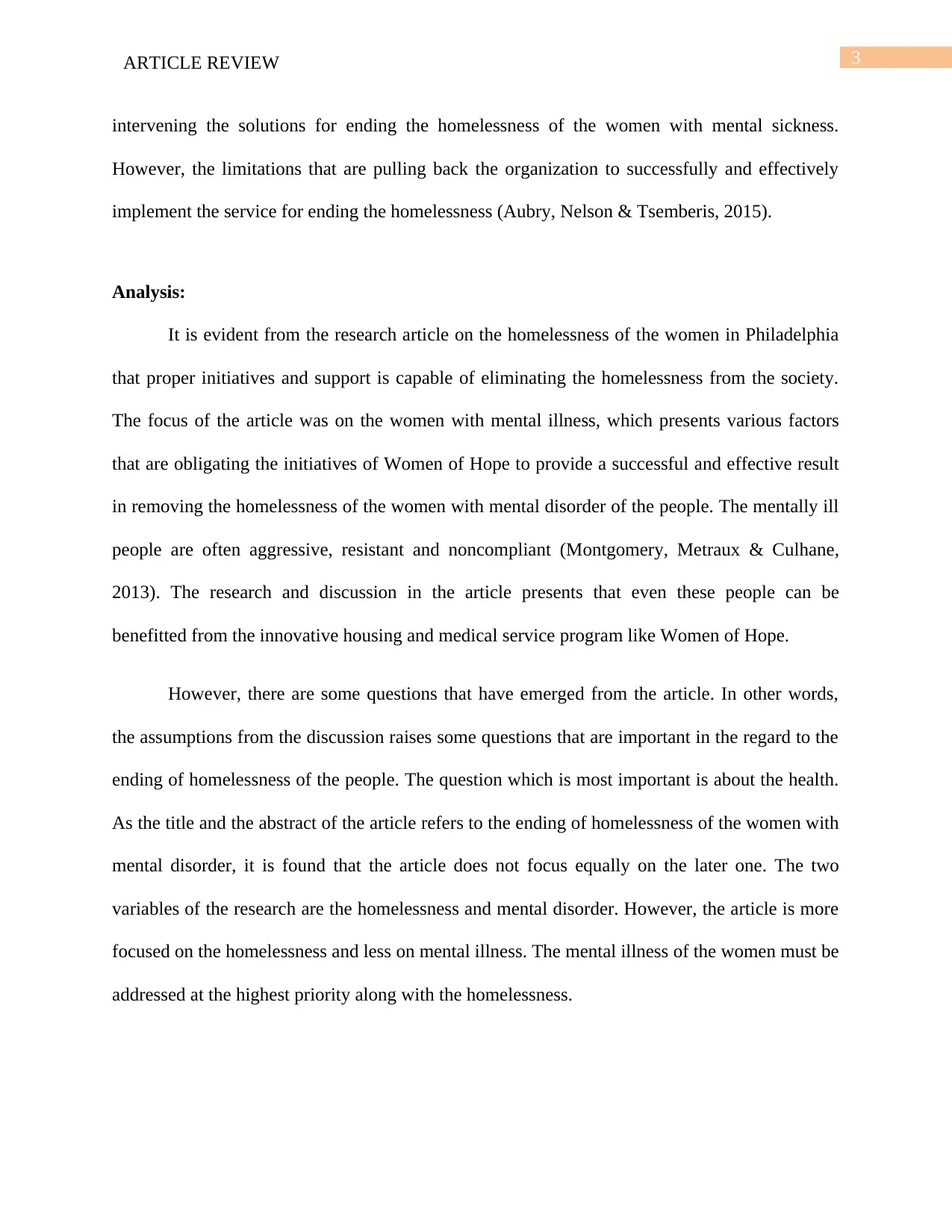
3ARTICLE REVIEW
intervening the solutions for ending the homelessness of the women with mental sickness.
However, the limitations that are pulling back the organization to successfully and effectively
implement the service for ending the homelessness (Aubry, Nelson & Tsemberis, 2015).
Analysis:
It is evident from the research article on the homelessness of the women in Philadelphia
that proper initiatives and support is capable of eliminating the homelessness from the society.
The focus of the article was on the women with mental illness, which presents various factors
that are obligating the initiatives of Women of Hope to provide a successful and effective result
in removing the homelessness of the women with mental disorder of the people. The mentally ill
people are often aggressive, resistant and noncompliant (Montgomery, Metraux & Culhane,
2013). The research and discussion in the article presents that even these people can be
benefitted from the innovative housing and medical service program like Women of Hope.
However, there are some questions that have emerged from the article. In other words,
the assumptions from the discussion raises some questions that are important in the regard to the
ending of homelessness of the people. The question which is most important is about the health.
As the title and the abstract of the article refers to the ending of homelessness of the women with
mental disorder, it is found that the article does not focus equally on the later one. The two
variables of the research are the homelessness and mental disorder. However, the article is more
focused on the homelessness and less on mental illness. The mental illness of the women must be
addressed at the highest priority along with the homelessness.
intervening the solutions for ending the homelessness of the women with mental sickness.
However, the limitations that are pulling back the organization to successfully and effectively
implement the service for ending the homelessness (Aubry, Nelson & Tsemberis, 2015).
Analysis:
It is evident from the research article on the homelessness of the women in Philadelphia
that proper initiatives and support is capable of eliminating the homelessness from the society.
The focus of the article was on the women with mental illness, which presents various factors
that are obligating the initiatives of Women of Hope to provide a successful and effective result
in removing the homelessness of the women with mental disorder of the people. The mentally ill
people are often aggressive, resistant and noncompliant (Montgomery, Metraux & Culhane,
2013). The research and discussion in the article presents that even these people can be
benefitted from the innovative housing and medical service program like Women of Hope.
However, there are some questions that have emerged from the article. In other words,
the assumptions from the discussion raises some questions that are important in the regard to the
ending of homelessness of the people. The question which is most important is about the health.
As the title and the abstract of the article refers to the ending of homelessness of the women with
mental disorder, it is found that the article does not focus equally on the later one. The two
variables of the research are the homelessness and mental disorder. However, the article is more
focused on the homelessness and less on mental illness. The mental illness of the women must be
addressed at the highest priority along with the homelessness.
Paraphrase This Document
Need a fresh take? Get an instant paraphrase of this document with our AI Paraphraser
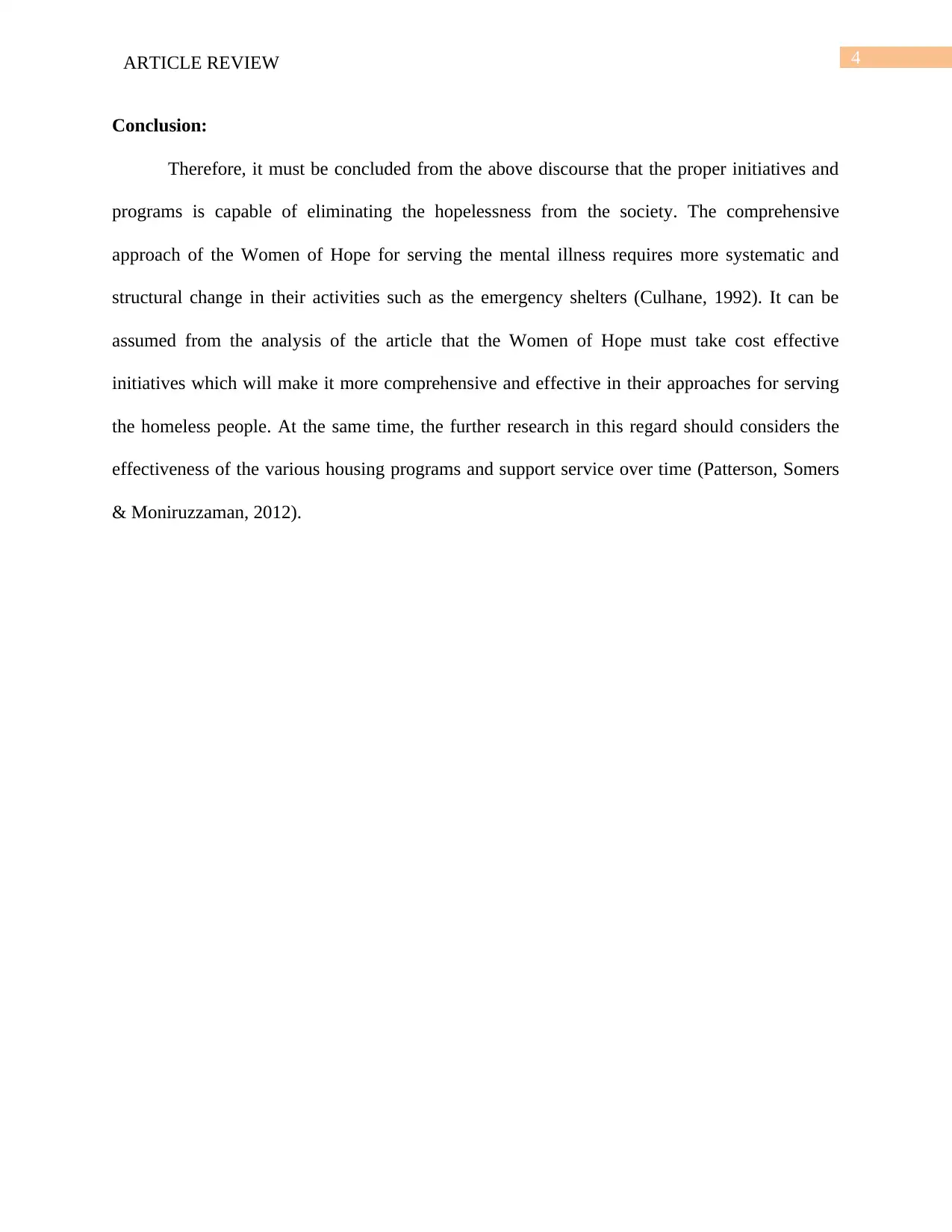
4ARTICLE REVIEW
Conclusion:
Therefore, it must be concluded from the above discourse that the proper initiatives and
programs is capable of eliminating the hopelessness from the society. The comprehensive
approach of the Women of Hope for serving the mental illness requires more systematic and
structural change in their activities such as the emergency shelters (Culhane, 1992). It can be
assumed from the analysis of the article that the Women of Hope must take cost effective
initiatives which will make it more comprehensive and effective in their approaches for serving
the homeless people. At the same time, the further research in this regard should considers the
effectiveness of the various housing programs and support service over time (Patterson, Somers
& Moniruzzaman, 2012).
Conclusion:
Therefore, it must be concluded from the above discourse that the proper initiatives and
programs is capable of eliminating the hopelessness from the society. The comprehensive
approach of the Women of Hope for serving the mental illness requires more systematic and
structural change in their activities such as the emergency shelters (Culhane, 1992). It can be
assumed from the analysis of the article that the Women of Hope must take cost effective
initiatives which will make it more comprehensive and effective in their approaches for serving
the homeless people. At the same time, the further research in this regard should considers the
effectiveness of the various housing programs and support service over time (Patterson, Somers
& Moniruzzaman, 2012).
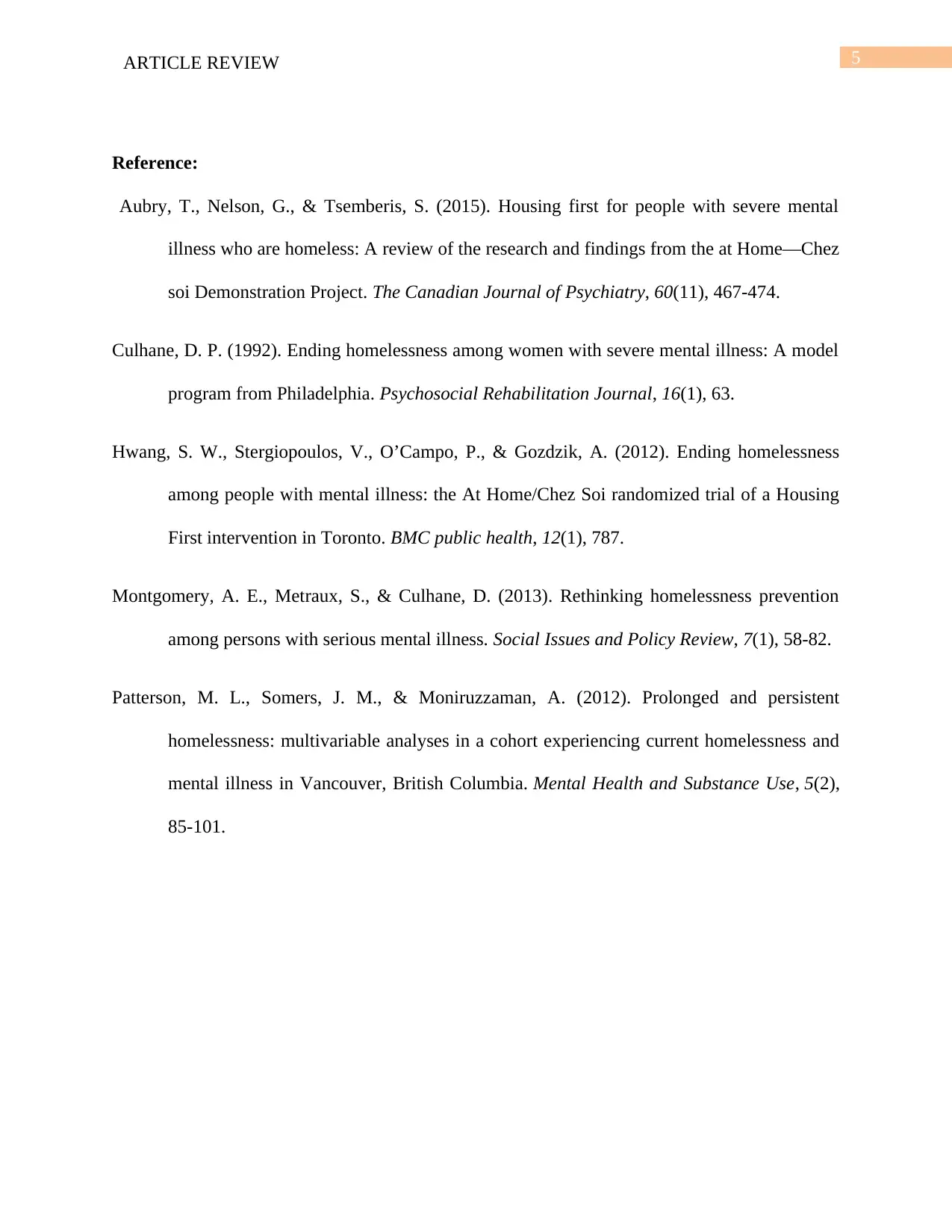
5ARTICLE REVIEW
Reference:
Aubry, T., Nelson, G., & Tsemberis, S. (2015). Housing first for people with severe mental
illness who are homeless: A review of the research and findings from the at Home—Chez
soi Demonstration Project. The Canadian Journal of Psychiatry, 60(11), 467-474.
Culhane, D. P. (1992). Ending homelessness among women with severe mental illness: A model
program from Philadelphia. Psychosocial Rehabilitation Journal, 16(1), 63.
Hwang, S. W., Stergiopoulos, V., O’Campo, P., & Gozdzik, A. (2012). Ending homelessness
among people with mental illness: the At Home/Chez Soi randomized trial of a Housing
First intervention in Toronto. BMC public health, 12(1), 787.
Montgomery, A. E., Metraux, S., & Culhane, D. (2013). Rethinking homelessness prevention
among persons with serious mental illness. Social Issues and Policy Review, 7(1), 58-82.
Patterson, M. L., Somers, J. M., & Moniruzzaman, A. (2012). Prolonged and persistent
homelessness: multivariable analyses in a cohort experiencing current homelessness and
mental illness in Vancouver, British Columbia. Mental Health and Substance Use, 5(2),
85-101.
Reference:
Aubry, T., Nelson, G., & Tsemberis, S. (2015). Housing first for people with severe mental
illness who are homeless: A review of the research and findings from the at Home—Chez
soi Demonstration Project. The Canadian Journal of Psychiatry, 60(11), 467-474.
Culhane, D. P. (1992). Ending homelessness among women with severe mental illness: A model
program from Philadelphia. Psychosocial Rehabilitation Journal, 16(1), 63.
Hwang, S. W., Stergiopoulos, V., O’Campo, P., & Gozdzik, A. (2012). Ending homelessness
among people with mental illness: the At Home/Chez Soi randomized trial of a Housing
First intervention in Toronto. BMC public health, 12(1), 787.
Montgomery, A. E., Metraux, S., & Culhane, D. (2013). Rethinking homelessness prevention
among persons with serious mental illness. Social Issues and Policy Review, 7(1), 58-82.
Patterson, M. L., Somers, J. M., & Moniruzzaman, A. (2012). Prolonged and persistent
homelessness: multivariable analyses in a cohort experiencing current homelessness and
mental illness in Vancouver, British Columbia. Mental Health and Substance Use, 5(2),
85-101.
⊘ This is a preview!⊘
Do you want full access?
Subscribe today to unlock all pages.

Trusted by 1+ million students worldwide
1 out of 6
Your All-in-One AI-Powered Toolkit for Academic Success.
+13062052269
info@desklib.com
Available 24*7 on WhatsApp / Email
![[object Object]](/_next/static/media/star-bottom.7253800d.svg)
Unlock your academic potential
Copyright © 2020–2025 A2Z Services. All Rights Reserved. Developed and managed by ZUCOL.
